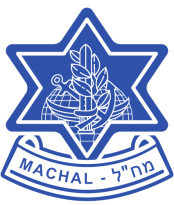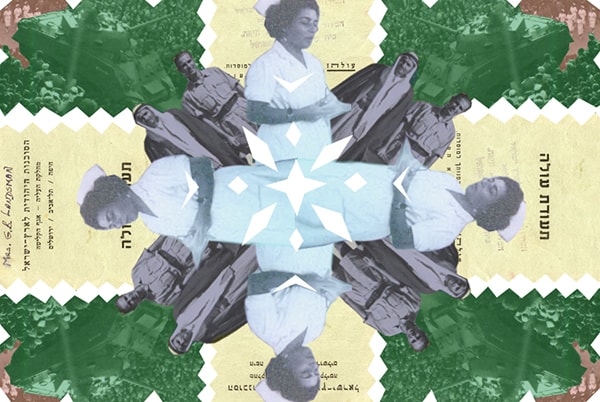
by Anne Landsman
When I applied to the graduate film program at Columbia University in 1982, I began my autobiographical essay with the first lines of the Brecht poem “Germany,” “Let others speak of their disgrace, I am speaking of my own.” I wrote about the shame of being a white South African growing up under apartheid, what it was like to live in a political system so overtly unjust and to be a member of the privileged few that benefitted from it.
I had arrived in New York City several months earlier with a backpack and the dream of going to film school. I was a greenhorn in all respects but didn’t sound like one because of my South African accent. At that time, the rand was strong against the dollar and when I was accepted into the film program my parents were able to pay the tuition. I was painfully aware of all those advantages, beginning many of my sentences with the word, “Sorry,” a peculiarly South African tic.
Immediately, this set me apart from my fellow students. I had also not grown up with TV—there was no television in South Africa until 1976, the year I graduated from high school, so had not watched Star Trek, Leave It to Beaver, I Love Lucy, or The Brady Bunch. I had also not watched the civil rights marches; heard Dr. Martin Luther King, Jr., speak; seen the film clip of John F. Kennedy’s assassination; seen TV footage of the Vietnam War. Culturally, I was an outsider, decades out of step with my peers.
My notions of America had come from the library I had grown up with. My parents had several American Jewish titles, as well as a vinyl record, You Don’t Have To Be Jewish, which was a collection of Jewish jokes. From the record I learned what an egg cream was. From Herman Wouk’s novel Marjorie Morningstar, I understood that Marjorie’s parents—who wanted her to marry a nice Jewish boy—were not too different than mine, despite the fact that she grew up on Central Park West and I grew up in Worcester, a small town in the wine region of the Cape.
I graduated from Columbia, became a screenwriter, then eventually an author, publishing novels that took place in South Africa and addressed the ways in which racism penetrated lives and distorted relationships, how the culture of violence I’d grown up with was all-pervasive. Although I continued to live in New York, in the world of my imagination I was in South Africa.
In 2011, along with other South African writers and academics, I was invited to attend a conference at Queen’s University in Ontario to honor J.M. Coetzee. This was to coincide with the Kingston Book Festival. During one of the breaks between sessions, a group of about 10 of us gathered together over tea and coffee. Two were Jewish—myself and an acclaimed nonfiction writer. Someone asked, “Do you think Israel is an apartheid state?” first looking at me, and then at the writer of nonfiction.
I was stricken, feeling a tearing of identities, my Jewish self sliding away from my South African self. Which one did I fully inhabit? Who was I going to answer for? And was it right to ask the two Jews in the room to speak for Israel? I mentioned B’nai Jeshurun, the progressive synagogue I belong to on the Upper West Side, and how there were many Jewish groups both in Israel and in the diaspora who worked for social justice but that I didn’t feel qualified to fully answer the question. The nonfiction writer, who had been to the West Bank with a South African delegation, was clear. In some ways, he said, what he had seen there was worse than apartheid South Africa.
I felt a knot tighten inside me. My parents had been part of the founding of the state of Israel, and they were lifelong Zionists. I had failed them, and I had failed myself by not answering adequately.
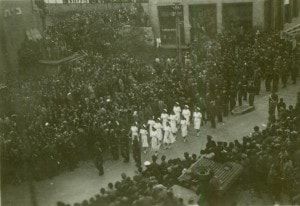
Nurses marching in the first Yom Ha’Atzmaut parade, Haifa, 1949. (All photos courtesy Anne Landsman)
“Al ha-beten, al ha-tzad hayamin, al ha-atzad smol, linshom amok.” “On your belly, on your right side, on your left side, take a deep breath.” These are the handful of Hebrew words my mother knew when she worked as an X-ray technician at Beit Holim Mispar Esser, Military Hospital No. 10, in Haifa during the 1948 War of Independence. She and my father, a medical doctor, flew illegally from Cape Town to Israel in August that year, two months after they were married. They were newly minted members of Mahal, the group of 4,000 Jewish and non-Jewish volunteers who came from all over the world to fight for Israel. The journey from the tip of Africa to the Middle East in an old Dakota DC3 was turbulent. My mother threw up several times. When they landed, they were to say they were tourists on their way to Italy. My mother carried in her luggage repair manuals and secret letters to the Haganah.
The medical volunteers all lived in close quarters. The food they had was inedible. The women took baths together to save hot water. Even getting a functional X-ray machine and film into the hospital was not straightforward. Many of their patients were Holocaust survivors. One man, with a broken arm or leg, who believed he was about to be gassed by the X-ray machines when my mother tried to X-ray him, grabbed the sleeve of her army jacket and wouldn’t let go. He screamed in a language no one could understand. The room filled with doctors and orderlies trying to pry him loose. The more they tried to pull him off my mother, the more fiercely he clung to her sleeve. Finally, she remembered a trick she learned from growing up with four brothers. She tickled him under the arm and he let go.
Seven years before she died at the age of 84, my mother gave me her collection of curling black-and-white photos from that time. In many of them, my mother, dressed in army uniform, is laughing and radiant. My father looks happy too, a dapper young man with a twinkle in his eye. Despite how difficult conditions were, they believed passionately in what they were doing, in the justness of their cause.
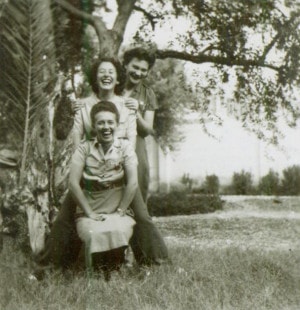
The author’s mother (center) with Roux and Benedict, two non-Jewish nurses brought to Israel from South Africa, 1949.
After the war ended, they came home. What prompted their decision not to make aliyah was never clear. What remained was the power of that year, visible in those tiny photos of my parents and their colleagues joking together in their living quarters in Haifa, my father in a heavy coat and scarf standing in front of a sandbagged bomb shelter in Jerusalem, my mother fixing her lipstick and smoking a cigarette on Nahariya Beach, my father doing a ward round, the very first Yom Ha’Atzmaut parade in Haifa. My mother had written approximate dates and some notes on the backs of the photographs. One photo was of an elegant stone villa with arches. On the back, she had written, “1948/49—house we commandeered to live in for short while.” Another photo—of both her and my dad standing with two men in front of a body of water—came with a story she’d penned in a brief note that she included with the photos. “Dad and I taken in Tiberias with 2 men—brothers—one said, ‘Tell your folks back home that you were friends with a “terrorrreeest” ’—the British shot him through both knees. His name was Silberman.” My parents had told the story of meeting Silberman and his brother many times—always with a certain relish at meeting a Jewish outlaw of this magnitude. I don’t remember if Silberman was a member of Etzel, Lehi, or the Stern Gang, but he left a lasting impression.
Then there’s the image of my mother and an Arab woman standing in front of a tree. On the back of the photo, she’d written, “Me and our Arab woman. Lived in basement of our living quarters.” In what looked like the same spot, she’d also posed with two non-Jewish nurses, Roux and Benedict, who had been recruited by the South African plastic surgeon Dr. Jack Penn to join his surgical team. The photographer must have said something funny because all three women are cracking up. My mother is captured mid-laugh, eyes closed, head thrown back. She looks so young, so beautiful.
***
That girl became a country doctor’s wife in Worcester, a small town in South Africa, raising three children during the apartheid years. She stopped working as an X-ray technician and ran my dad’s office instead. Her Zionism never left her, and she was an active member of W.I.Z.O., the Women’s International Zionist Organization, for most of her life. The first adult book she gave me to read was Exodus, by Leon Uris. I was 8 at the time, and I was as riveted by the drama of the founding of the state of Israel as I was by the smoldering love between Ari Ben Canaan and nurse Kitty Fremont, reading the description of their first kiss over and over again. She undressed in the dark! He carried her to the bed! This, too, was a new country.
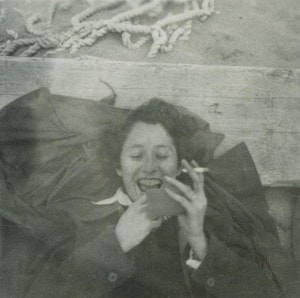
The author’s mother fixing her lipstick and smoking a cigarette on Nahariya beach, 1949.
The whole subject of Israel was bathed in a romantic glow, my parents’ youthful idealism and bravery melded with the characters. It was all a welcome escape from the predictability of life in segregated Worcester. The synagogue, where the Jewish community of 30 families met and prayed, was on Durban Street, the street that divided the White area from the “Coloured” or mixed-race part of town. The mosque was a few blocks away, on the same street. My father liked to speak of the similarities between Islam and Judaism. “We are brothers,” he often told his Muslim patients.
In the rigid racial hierarchy, Jews were in an ambiguous position—privileged as Whites, but not always fully accepted socially by either Afrikaners or South Africans of British descent. The synagogue on Durban Street was the locus of all community activities—both religious and secular. It was where Betar, the Revisionist Zionist youth movement, found a foothold in the 1970s. All the Jewish children in the town signed up except for me. (My older siblings had already left home at that point.) My parents were dead against me joining Betar, seeing it as too right-wing, too politically conservative. I was happy to comply. Their words carried weight. They were war heroes.
The year I graduated from high school, 1976, was also the year of the Soweto riots, where black high-school students protested against the introduction of Afrikaans as the medium of instruction in their schools. About 20, 000 students participated. According to the official count, 176 students were killed, although some estimates come closer to 700. During the years that followed, the townships were often in flames. The Nationalist Party government tried its best to quell the unrest, imposing ever more draconian laws, making arrests, detaining protesters without trial.
These were heady times to be at university. The students I most admired were at the forefront of the anti-apartheid struggle. Several were under house arrest. Another, who was born in Zimbabwe, was detained and then deported. Many young men I knew left the country to avoid the draft.
The world around me cracked open. Everything was in question. In my third year at the University of Cape Town, I came home to Worcester with a friend one weekend. We were sitting outside in the garden having Sunday lunch with my parents in the shade of a tall tree my brother had carved his initials into, when I thought I would broach the subject of Israel and the Palestinians. I wasn’t sure myself how I felt about the accusations leveled at Zionism, the parallels drawn between Israel and South Africa.
I had always thought of my parents as more open-minded than most in our town. They remembered when the Nationalist Party came into power in 1949 and vividly recalled what it was like to witness the framework of legally enforced racial segregation emerge around them. They described seeing the signs go up that read, “Europeans Only,” “Non-Europeans Only,” or, more bluntly in Afrikaans, “Blankes,” “Nie-Blankes” (“Whites,” “Non-Whites”), and how disturbing it felt, how it reminded them of the prohibitions and restrictions that ultimately led to the destruction of European Jewry.
Something else that set them apart was their habit of taking out-of-town visitors on an “apartheid tour.” We would crowd into my father’s white Valiant and drive past Durban Street to Roodewal and Riverview, new sub-economic housing developments with row upon row of pastel-colored, one-room concrete block houses called “ice chessies” because they were so cold in winter. They felt that their friends from Cape Town had never seen that side of South Africa and that it was their duty to show them how grim it was.
In the sunlit garden, I posed the question, “Don’t you think the Palestinians should have a voice?” There was a moment of stillness while the words sank in. Then my father stood up and turned the table over, screaming about the Arabs who had fled their villages of their own volition, the Holocaust survivors he’d treated, the world that had allowed the genocide to happen. The entire meal—tablecloth, roast chicken, salads, plates, knives, forks, glasses, and a bottle of wine—tumbled onto the grass. Not much was said after that. My friend and I drove back to Cape Town over the Du Toitskloof Pass that afternoon in total silence.
***
It’s November 2014, and I’m at JFK airport, checking in at the El Al counter, bound for Tel Aviv. It has been over 30 years since I left South Africa. Both my parents are no longer alive. The garden we sat in that day when my father overturned the table is gone. The house was sold, the tree that shaded us has been cut down, and the lawn bricked over and turned into a parking lot. Apartheid is gone too, and South Africa is now a democracy.
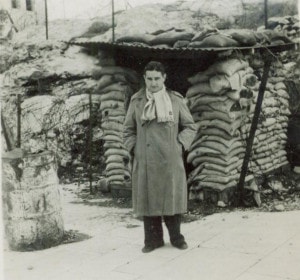
The author’s father stands outside a Jerusalem bomb shelter, 1948-1949.
I’m married to James, an American, and have two teenage children, Tess and Adam, who have recently left home for college and boarding school, respectively. In the intervening years, I have been to Israel twice—once as a university student volunteering at Kibbutz Ramot Menashe for three months, and the second time James, Tess, Adam, and I went as a family with our synagogue.
At the airport, I answer the questions of the El Al security person who is holding my passport and looking intently at me. I say I’m a writer and am going to Israel partly for work, partly for pleasure. I plan on visiting the hospital in Haifa where my parents volunteered in 1948 with the intention of writing about it some day, and I also plan on re-connecting with old friends. She softens visibly when I tell her my parents were Mahalniks, and she writes her grandfather’s name down on a piece of paper. “He lives in Haifa,” she says. “He was around at that time and may be able to help you.”
In my hand luggage, I have a copy of the “Decoration of State Warrior” certificate from Israel’s Ministry of Defense honoring my mother for her “active service laying the foundations for the establishment and security of the state” as well as a photo of the medal she received. I want to go to the Mahal office in Tel Aviv and follow up on getting my father the same honor, I tell her.
What I don’t mention is that I’m also going to be taking a two-day trip to the West Bank with Encounter, an American organization that, according to its mission, promotes face-to-face contact between Jews and Palestinians “as a means of strengthening the capacity of the Jewish people to be agents of change.” Along with Jewish communal leaders and educators, I will be visiting the Bethlehem area where we will hear Palestinian peace activists, community and religious leaders, and local businesspeople talk about the reality of their lives. This too, I plan to write about, attempting to wrestle with the painful questions I have avoided answering for so long. I have a healthy respect for authorities at any border, so I don’t complicate matters by mentioning any of this.
The plane ride is long, the aisles jammed with parents comforting babies, men in black hats swaying and praying. Someone opens the overhead luggage compartment and a large menorah wrapped in bubble wrap almost falls out. It’s impossible not to notice that this plane is full of Jews. In the deepest part of myself, something lifts, soars.
At the hotel in Tel Aviv, Ralph, a Dutch Jew, checks me in. His parents were German, and he tells me that they gave him a British-sounding name to protect him during the war years. He hands me the keycard, mentioning that he’s upgraded me to a better room. Whether it’s true or not, I’m thrilled when I open the door and see a glorious view of the Mediterranean, glittering and blue in the sunlight. Dizzy with excitement and fatigue, I decide not to waste a minute of what’s left of the day. I drop my bags and head straight to the Mahal office before it closes to set in motion the process of getting my father his posthumous medal and certificate.
The next day’s agenda is simple: Find Beit Holim Mispar Esser. I remember the phrase rolling off my father’s tongue with great emphasis, as if it was the password to a long-forgotten world of high drama that also contained moments of unspeakable hilarity. In the X-ray department where my mother worked were two Beckettian orderlies, Tabaznik and Rubenstein, who often took long lunch or tea breaks when they were supposed to be fetching patients from the wards for X-rays. One had steel teeth, the other wept constantly from one eye. The mere mention of their names would evoke gusts of laughter from my parents.
What I have learned is that No. 10 Military Hospital was the old Italian Hospital in Haifa, opened in 1907 to offer assistance to Italian missionaries. The British later used it as an army hospital. When the British withdrew from Palestine in May 1948, they left it with broken windows, sterilizers with holes punched through them, feces smeared on the walls of the operating theaters. The Israel Medical Corps took it over and reopened it several months later as Beit Holim Mispar Esser. In the early 1950s, it went back to being the Italian Hospital run by the Franciscan Missionaries of the Immaculate Heart of Mary.
The building reveals none of the convulsive changes it has been through. It is gracious, four-storied, with elegant arched windows and small balconies. I’m not sure what I’m going to find inside. Something of the world my parents described, with its trauma and uncertainty? The still-echoing screams of the survivor who was afraid the X-ray machines were going to gas him? Tabaznik and Rubenstein playing hooky somewhere? Of course it’s all long gone. The interior is immaculate, cool, a welcome respite from the warm day. I explain to someone in reception that my parents once worked here, during the war in 1948. She tells me that she has no information about that period at all. There is a doctor, Dr. Toubi, who knows about the building’s history, if he hasn’t left for the day already.
Thankfully, he is still here. I shake hands with a clean-shaven man around my age, his gaze steady and kindly. Since I come from a medical household, he immediately feels like family. I know the scent of well-washed hands so well, the air of attentiveness, concern. Suddenly, I miss my father. I babble my story, my voice wavering a little. He is moved, too. We are two middle-aged people who understand loss, what life is like when one’s parents are gone.
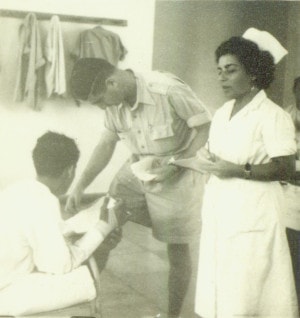
The author’s father (center) performing a ward round, 1948-1949.
He points to the tiled floor in the room we are in, with its distinctive motif of small dark squares in a field of cream-colored ones, bordered by a ladder pattern. “This,” he says, “is the original floor.” In all the other areas of the hospital, the intricate tilework has long since been replaced by a simpler, modern design. Again, I feel a surge of emotion, wishing I could tell my mother and father where I am, that I am walking where they once walked.
After showing me a series of old photographs of the hospital when it was first built, Dr. Toubi takes me to one of the upper floors where the X-ray department might have been. Nothing is left of what was once there. He tells me that the hospital acquired a cobalt machine in 1956, the first hospital in the area to have one. We are on a balcony now, with a view of trees, buildings, the sea. I am having difficulty matching what I am seeing with the world depicted in the images my mother left behind.
Back on the ground floor, he tells me his family has been in Haifa for eight generations. His father, Tawfik Toubi, was the head of the Communist Party, a member of the first Knesset. (Days later, I learn from a writer friend that the Toubis are Israeli Arabs and what a respected and controversial figure Tawfik Toubi was.)
I tell Dr. Toubi about my plans to go to Bethlehem with Encounter, describing the organization and its mission. In the last few weeks, I have found myself using this as a Rorschach test, to see how people react. In the United States, several of my friends and acquaintances, afraid for my safety, cautioned me to be careful. In Israel, I hear this too, sometimes mixed with a cynicism about how difficult the situation has become, how intractable, as if the Encounter experience I am about to undergo is an American Jewish folly, a naïve fantasy of an unreachable peace. The doctor has a very positive response, saying that the only solution to the conflict will come about through talking and negotiation. He tells me how pleased he is that I am here to do this, and that I am welcome to come back to the hospital any time.
***
The Sunday prior to the trip, I meet my Encounter group at an orientation in Jerusalem. There are about 35 of us, including the two trip leaders, Rebecca Polivy and Shani Rosenbaum, plus nine facilitators. Almost all are American Jews, many of whom who are either rabbis or rabbinical students. Others are social workers, educators. Some live in Israel, most live in the United States. The majority are much younger than me, several around the age my parents were when they came to Israel in 1948. I am immediately struck by their seriousness and their passion.
We sit in a large circle. Each of us has to mention who we are bringing on the trip, and why, in two minutes or less.
I am bringing my South African parents, I tell the group. I mention that they were Mahalniks in 1948 but I don’t mention the overturned table that effectively ended any meaningful discourse with them about Israel from that day forward. All I say is that I grew up hearing one story but that there’s another story I want to hear.
We are introduced to the Encounter communication guidelines, which include the idea of “listening with resilience.” In the participant booklet, it is expanded upon: “Encounter suggests that listening, specifically in the context of the Israeli-Palestinian conflict, is a radical act. … ‘Resilient listening’ allows a person and/or a community to live with tension, to hold multiple perspectives at the same time, and to continue to be open to what is new rather than guarding against it and shutting down.” This was never my father’s forte, I reflect, remembering the sickening slide of food, dishes, silverware, and glasses onto the ground so many Sundays ago.
Nor has this been a season for much listening. On Nov. 5, the day I left the United States for Israel, a Hamas operative drove a van at high speed into a crowd of people waiting at a light-rail station in Jerusalem. Several people (including the driver who was shot) died. On Oct. 22, there was a similar attack in East Jerusalem that killed two civilians, a woman and a baby. Tensions have escalated in the West Bank, and, on Nov. 11, a young Palestinian man was shot and killed by the IDF in the Al-Arroub area between Bethlehem and Hebron.
On Nov. 12, the day before my Encounter trip, I take a taxi from Jerusalem to the Bethlehem checkpoint, planning to see the city with a tourguide. In terms of the Oslo Accords, Bethlehem is part of Area A, which is fully controlled by the Palestinian Authority. With the Encounter group, I will be in Areas B and C, outside of Bethlehem.
The taxi driver is too nervous to get too close to the checkpoint so he drops me about 100 yards away. It’s 9 a.m. and Palestinian workers are streaming through what looks like a giant cage. The mood is somber, tense. I remember visiting Bethlehem in 1977 (before the separation barrier, before the checkpoints), and what I’m seeing is a shocking testament to how bad the situation has become. Everyone seems to be leaving Bethlehem, no one seems to be entering. I’m confused about which way to go, expecting to see a clearly marked entry point or a booth with IDF soldiers, but they appear to be well-hidden, tucked behind a series of Kafkaesque high fences and walls. I walk through the empty maze not seeing a soul.
A familiar feeling seizes me. I’m on high alert. It takes me back to my South African childhood, hearing sirens, screams, the guttural voices of the police in the night, a sense of impending doom ever present. I know this isn’t unsafe—tourists stream into Bethlehem every day to visit the religious sites—but the soulless architecture of the checkpoint terrifies me. When I exit into the street, crowds of taxi drivers come toward me, offering their services. The streets are poorly paved, the buildings run-down. I feel as if I have stepped through the looking glass.
I realize I’m walking where my parents didn’t walk but I am taking them with me, and, when things frighten me, I remember that my mother was 23 and my father was 28 when they volunteered for war. For the first time, I think about how brave they must have been and how scared they must have felt.
With a tourguide, I visit several historical sites as well as Aida Refugee Camp. I get the opportunity to see the imposing concrete separation barrier up close, as well as from far away. I see it cut through homes, dividing neighbors from one another. I see its defiant, graffitied face, as well as its stern, gray one, where long stretches of it separate Palestinian towns from Israeli settlements. At its highest, it reaches up to 26 feet. From within its boundaries, I look out at the red roofs of the settlers’ homes in the distance.
How can I not remember our Sunday drives, where we drove across Durban Street into Roodewal and Riverview where the pastel-colored “ice chessies” were? How can I not think of Mr. Aesop, the Indian man who sold vegetables to my mother who had to move his business from what was declared a White area to where the “Coloured businesses” were? Or the Zwelenthemba township, even further from the town center, whose Xhosa inhabitants had no permanent residency status? How can I not think of separation as something shameful?
When we visit the Lajee Center, which is in the refugee camp, there’s some activity in the street. Boys are throwing stones at the IDF soldiers at the other end of the block. The tourguide hurries me into the building before I have time to fully take in the situation. Business as usual, he informs me. This happens every afternoon. Teenagers taunting teenagers.
The soldiers fire a teargas canister at them. A cloud of white smoke fills the street. I immediately want to flee, remembering the South African township riots of the 1970s and ’80s all too well, the way things can turn sickeningly from stone-throwing into chaos. Both the tourguide and the director of the Lajee Center point out that we can’t leave until the tear gas clears. The boys come inside and go on the computers and do their homework. No one seems particularly perturbed.
My heart is racing, and my hands are cold as ice. I’m also deeply ashamed at how scared I am, how vulnerable I feel. The director is delivering facts and figures. There are 57 Palestinian refugee camps in Palestine, Lebanon, and Jordan. There were 800,000 Palestinian refugees in 1948 when 530 of their cities and villages were destroyed. There are close to 6 million now.
I’m trying to practice resilient listening as my head reflexively fills with a counter narrative, the one that I grew up with: the stories of Arabs fleeing of their own volition in 1948, the Holocaust that exterminated a third of the world’s Jewry, my parents’ pride at their part in the creation of a Jewish state.
We look out of the window at the Aida refugee camp, built by UNRWA in 1950. Where there were once green tents, there are now two-room cinderblock housing units, 100 square meters each. Still living in the same area, the refugee population has increased fivefold.
The tear gas has finally cleared, and we leave. The tourguide runs to the car, and I follow. A tall gate has been pulled closed in the area where he parked it. Rocks have been inserted under the gate. A group of boys appear and again, my heart plummets, as I’m not quite sure what they’re going to do, or what’s going to happen next. Instead of starting another round of stone-throwing, they help us lift the gate and roll the rocks away. The tourguide puts his foot flat on the accelerator, and we speed off, bumping along the uneven, ill-paved road.
The moment that undoes me, though, is not when we’re in Area A, but when we’re driving on one of the roundabout highways created to bypass Bethlehem and connect Jerusalem to one of the settlements. It’s smooth, well-kept, and here the separation barrier is lower and clad in aesthetically pleasing stone. It looks like a barrier you would see along a highway anywhere in the world. Now, more than ever, I feel my South Africanness, all the immaculate highways of my childhood that kept me far away from the ice chessies, the squatter camps and the townships, that kept me in my white world. Only on those Sunday drives, out of the window of the Valiant, did I see that other world, where the good roads ended and the potholes began.
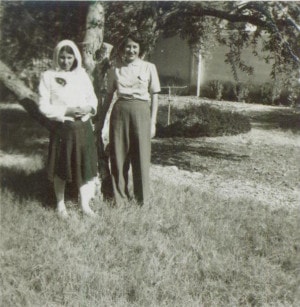
“Me and our Arab woman – lived in basement of our living quarters.” – the author’s mother (right) and a neighbour, 1948-1949
Over the next few days, as I fully enter the Encounter experience, listening to Palestinian speakers describe the difficulty and tragedy of their lives, touring Khalet Zakariya (a struggling Arab village choked by the surrounding settlements), seeing where the separation barrier moves away from the Green Line and encroaches into the West Bank, that South Africanness is with me. When Ali Abu Awwad, a charismatic activist who promotes nonviolence, tells us, “To shoot someone takes a minute, to change someone’s mind takes years,” I think of my own journey, how it has taken me a lifetime to get here. On the subject of Israel and South Africa, Ali, who has lost his brother in the conflict, has this to say: “Saying the occupation is apartheid closes people down. I don’t need to be right. I want to succeed.” He acknowledges Nelson Mandela’s influence on his life, as well as Gandhi’s.
Part of our itinerary includes an overnight homestay with the Palestinian families who will be joining us for community-building games and dinner. In groups of two, we were assigned to various families and would be returning with them to their homes after dinner. With great sadness, our organizer announces that it has been canceled because tensions in the area have escalated and the risk has become too great. This is extremely awkward as the Palestinian homestay families are known for their open-hearted hospitality, and the night with them is often a cornerstone of the Encounter experience. Despite this setback, they all join us for the evening. One man, swallowing his hurt pride, tells me how upset he is but that he decided to come at the last minute. He says, “Canceling the homestay touched me. I felt I was building a trust. And now I feel as if the trust is broken.”
We talk and gradually he relaxes. The night is about repair and regaining his trust. His community and mine eat together, talk, laugh, play games, dance. I often feel tears well up at the fragility and beauty of what we are doing and the stories we are hearing.
Over the next 24 hours, we learn of extreme water shortages in the West Bank, particularly in summer. It is difficult for Palestinians to get building permits, including permits to build schools. An ambulance driver talks of his experience of driving a 65-year-old woman who had an infected wound from spinal surgery to a hospital and being bullied by an Israeli border guard at a checkpoint. The guard asked, “Are you a doctor or a shoe?” and insisted that he had a bomb in his ambulance. A prominent Palestinian businessman who was born and educated in the United States but has raised his family in the West Bank describes the Israeli stamp in his U.S. passport that has restricted his movements. There are the olive harvests destroyed by settlers, the Palestinian children who have never seen the sea, all the daily indignities of life under military occupation.
***
But is it apartheid? I realize that I am no longer the 21-year-old who compared the South Africa of my youth to Nazi Germany, my shame at my white privilege to Bertolt Brecht’s agony at watching his country descend into madness. I have come to Bethlehem to see across the divide between Jews and Palestinians and, at moments, have been forcefully reminded of the sights and sounds of my childhood, but I cannot equate the one social system with the other. The South Africans were not Nazis, just as the Israelis are not South Africans. Israel is different from South Africa in the wrenching story of its founding, its history, its legal and political system, the centrality of Jerusalem to three faiths, the small size of the country, its paucity of natural resources, its geography, its weather… so different, in so many countless ways.
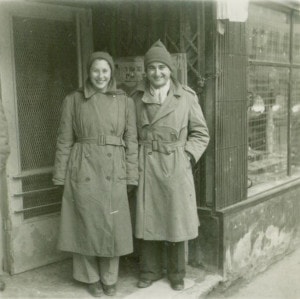
“The coldest we have ever been.” – the author’s parents in Jerusalem, 1948-1949
In many of the Jewish Encounter participants, what I am seeing is my parents’ younger selves. They too have come to Israel at a critical moment in their lives. They too are making big decisions about where they are going to live and who they are going to be. Over and over again, I am awed by their passion, their struggle, and their heartbreak as they think about what tikkun olam means to them. They are questioning their teachers, their parents, their rabbis, asking the same question I asked under that tree so long ago.
I think about the choices I have made in my own life—how I was raised to leave South Africa, how my parents stayed behind, even when all their three children immigrated to America. Even though I left one country for another, what I took with me was my Judaism, and it was inextricably linked to Israel.
At Neilah every Yom Kippur, I sing Hatikvah with my fellow congregants with hope and yearning. I pray for peace, year after year. But now, when I look out at the rocky, biblical landscape near Bethlehem, I can’t help thinking of the arid semi-desert of the Karoo, close to where I was born. Although my parents were first-generation South Africans—their parents all emigrated there from Lithuania—it’s the tug of those shallow roots I’m feeling now.
Perhaps my parents didn’t make aliyah because they could leave the memory of their remarkable year intact. They could live the daily brokenness of South Africa while keeping their long distance love affair with Israel alive. They could be ashamed of South Africa, but proud of Israel.
No wonder my father turned that table over with such vehemence.
Originally published in Tablet Magazine
